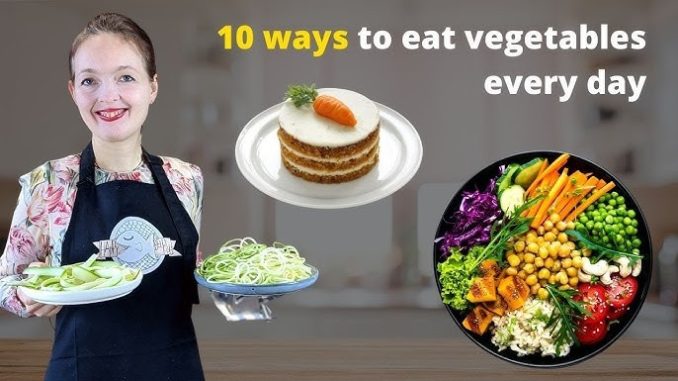
For many people, eating more vegetables feels like another item on the endless list of things they “should” be doing for their health. The thought of piling extra greens on the plate or forcing down salads can make the goal seem more like an obligation than a natural part of daily life. Yet vegetables are some of the most powerful foods for supporting energy, digestion, immunity, and long-term health. The challenge is not in knowing they are good for us, but in making them so accessible and enjoyable that they become part of the routine without much effort. The key lies in subtle adjustments—changing the context in which vegetables appear so they become an easy addition rather than a forced task.
One of the simplest ways to eat more vegetables without trying is to integrate them into meals that are already familiar. Instead of reinventing the wheel, think about foods you already enjoy and where vegetables can be blended in without altering the experience. For example, adding spinach to an omelet, tossing shredded carrots into a pasta sauce, or mixing extra peppers and onions into a stir-fry enriches the meal with nutrients without making it feel like a departure from your usual choices. These additions are often so seamless that you barely notice the difference in taste, but the nutritional impact compounds over time. It is much like improving a business system by streamlining existing processes rather than overhauling the entire operation—small enhancements can yield significant results.
Another approach is to make vegetables more visible and accessible. Often, the barrier is not preference but convenience. When healthier foods are tucked away while snacks sit front and center, the easier choice wins. By preparing vegetables in advance and placing them within reach—sliced cucumbers in the fridge, cherry tomatoes in a bowl on the counter—you set yourself up to eat more without conscious effort. This mirrors the professional principle of designing environments for success. Just as clear workflows reduce friction in the workplace, an environment that makes vegetables the default option increases the likelihood of eating them naturally.
Blending vegetables into foods and drinks is another strategy that works without much thought. Smoothies, for example, provide a perfect backdrop for vegetables like spinach, kale, or even zucchini, which can be added without drastically changing the flavor. Similarly, soups, stews, and casseroles naturally accommodate extra vegetables, often enhancing flavor and texture. These dishes allow for variety without requiring you to eat vegetables in isolation. In this way, vegetables become part of the whole rather than a side dish that feels obligatory. It is comparable to building collaboration into team projects—when contributions are embedded in the process, they feel natural rather than forced.
Shifting perspective also makes eating more vegetables easier. Instead of thinking of them as something you “have” to eat, see them as tools for energy, focus, and resilience. A lunch filled with colorful vegetables often leaves you feeling lighter and more alert in the afternoon compared to a heavier meal with few plant-based ingredients. Professionals who pay attention to how food affects their productivity will notice these differences quickly. Framing vegetables as performance fuel rather than dietary duty makes it easier to welcome them into your meals. This mindset shift is similar to how organizations frame policies as opportunities for growth rather than restrictions—when the purpose feels empowering, consistency follows naturally.
Snacking provides another effortless opportunity. Replacing part of an existing snack with vegetables can make a big difference without feeling restrictive. Pairing carrots with hummus, cucumbers with cheese, or bell peppers with guacamole is satisfying and nutrient-rich. These choices do not require giving up enjoyment; they simply reframe what snacking looks like. Over time, this builds into a habit that reduces cravings for processed foods while boosting nutrient intake. It is the same principle professionals use when substituting unproductive meetings with quick check-ins: the value is preserved, but the efficiency improves.
Cultural and culinary creativity can also make vegetables less of a chore. Exploring dishes from cuisines that naturally highlight vegetables—Mediterranean, Middle Eastern, or Asian, for example—introduces new flavors and techniques that make plants the star without trying. A colorful Thai curry or a Greek salad feels exciting, not forced. This approach highlights how variety and curiosity can transform healthy eating into an enjoyable exploration rather than an obligation. Much like diversifying business strategies opens new markets and opportunities, diversifying food choices makes it easier to sustain healthier habits.
Ultimately, eating more vegetables without trying is about removing friction and making them part of your existing patterns. It is not about willpower or strict rules but about design—structuring meals, environments, and perspectives in ways that naturally favor nutrient-rich choices. When vegetables are seamlessly integrated into foods you already enjoy, placed where they are easy to grab, and associated with positive outcomes like energy and focus, they stop feeling like an obligation. They simply become part of the rhythm of eating.
For professionals, this approach aligns with the principle of efficiency. Just as the most successful organizations do not waste resources reinventing every system but instead make small, strategic adjustments, individuals can improve health by making vegetables a natural part of their lives without overthinking it. The long-term benefits—better energy, stronger immunity, clearer focus—come not from dramatic dietary overhauls but from these quiet, consistent shifts. By approaching vegetables with simplicity and creativity, you can eat more of them almost without noticing, giving your body what it needs to thrive while keeping your routines enjoyable and sustainable.
Would you like me to also create a condensed 400–500 word version of this article that could be used in newsletters or as a professional wellness insight on LinkedIn?